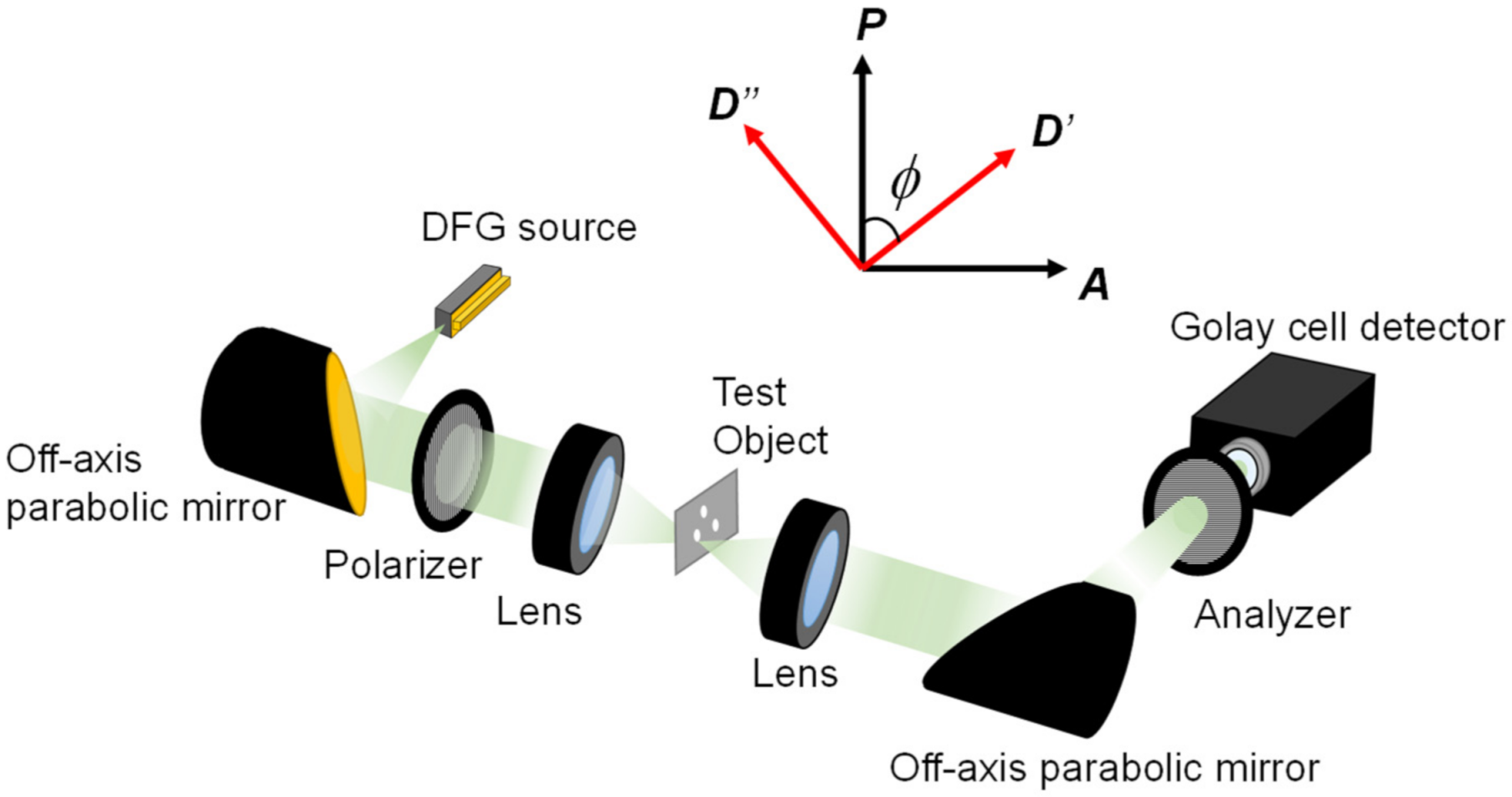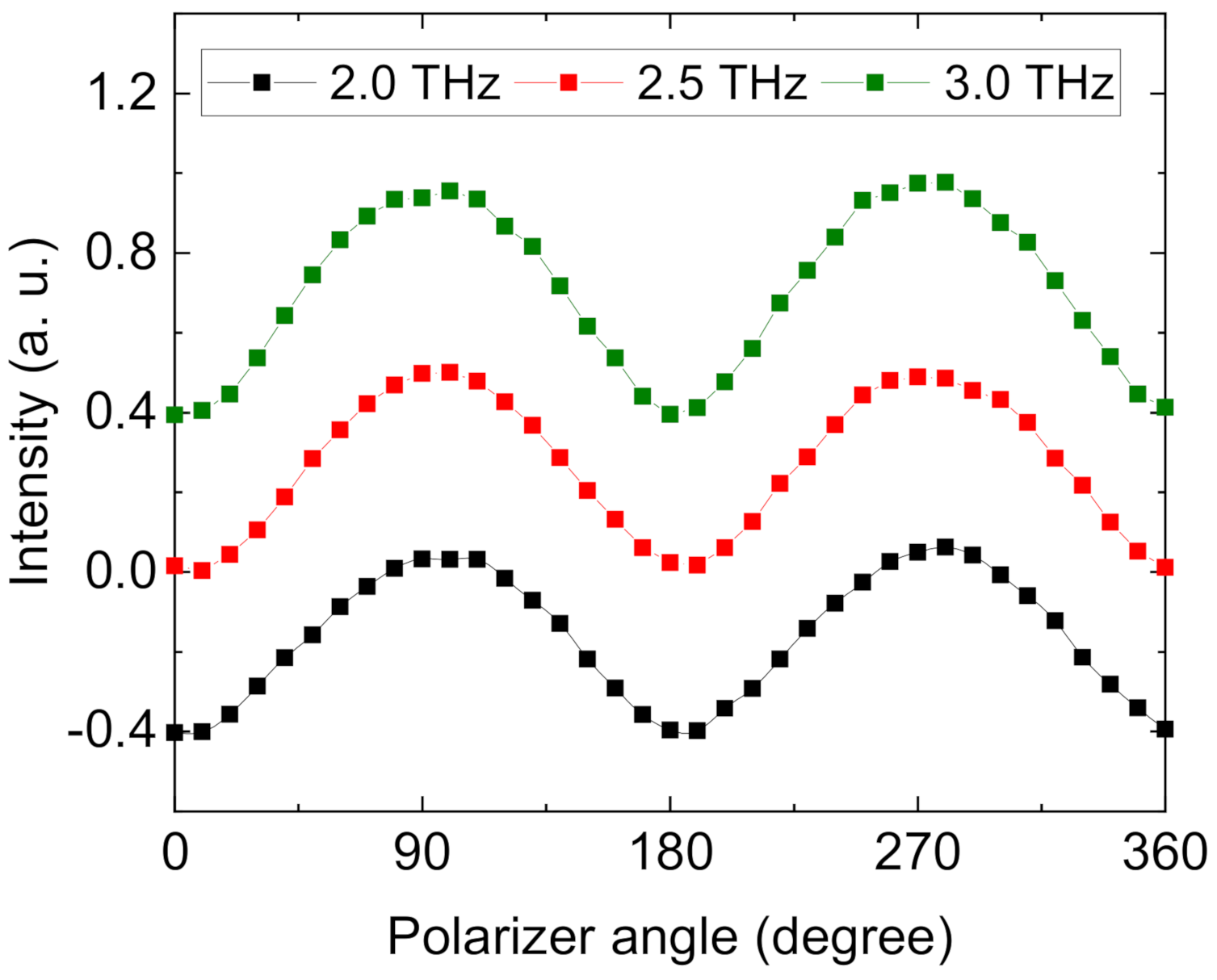Polarization Imaging of Liquid Crystal Polymer Using Terahertz Difference-Frequency Generation Source
Abstract
:1. Introduction
2. Materials and Methods
3. Results and Discussion
3.1. Terahertz Optical Properties of LCP
3.2. THz Imaging of LCP
4. Conclusions
Author Contributions
Funding
Institutional Review Board Statement
Informed Consent Statement
Acknowledgments
Conflicts of Interest
References
- Lan, Y.; Xu, Y. Bending Limit Tests for Ultra-Thin Liquid Crystal Polymer Substrate Based on Flexible Microwave Components. Micromachines 2018, 9, 531. [Google Scholar] [CrossRef] [Green Version]
- Jilani, S.F.; Munoz, M.O.; Abbasi, Q.H.; Alomainy, A. Millimeter-Wave Liquid Crystal Polymer Based Conformal Antenna Array for 5G Applications. IEEE Antennas Wirel. Propag. Lett. 2019, 18, 84–88. [Google Scholar] [CrossRef] [Green Version]
- Mizuno, M.; Kitahara, H.; Sasaki, K.; Tani, M.; Kojima, M.; Suzuki, Y.; Tasaki, T.; Tatematsu, Y.; Fukunari, M.; Wake, K. Dielectric property measurements of corneal tissues for computational dosimetry of the eye in terahertz band in vivo and in vitro. Biomed. Opt. Express 2021, 12, 1295–1307. [Google Scholar] [CrossRef] [PubMed]
- Takeuchi, I.; Otsuki, M.; Kuroda, H.; Makino, K. Estimation of crystallinity of indomethacin by usage of terahertz time-domain spectroscopy and calibration curve: Correlation between crystallinity and solubility. J. Drug Deliv. Sci. Technol. 2018, 45, 70–75. [Google Scholar] [CrossRef]
- Bawuah, P.; Zeitler, J.A. Advances in terahertz time-domain spectroscopy of pharmaceutical solids: A review. TrAC Trends Anal. Chem. 2021, 139, 116272. [Google Scholar] [CrossRef]
- Puc, U.; Abina, A.; Jeglic, A.; Zidansek, A.; Kasalynas, I.; Venckevicius, R.; Valusis, G. Spectroscopic Analysis of Melatonin in the Terahertz Frequency Range. Sensors 2018, 18, 4098. [Google Scholar] [CrossRef] [PubMed] [Green Version]
- Cheng, Y.; Wang, Y.; Niu, Y.; Zhao, Z. Concealed object enhancement using multi-polarization information for passive millimeter and terahertz wave security screening. Opt. Express 2020, 28, 6350–6366. [Google Scholar] [CrossRef] [PubMed]
- Okano, M.; Watanabe, S. Inspection of internal filler alignment in visibly opaque carbon-black–rubber composites by terahertz polarization spectroscopy in reflection mode. Polym. Test. 2018, 72, 196–201. [Google Scholar] [CrossRef]
- Naftaly, M.; Vieweg, N.; Deninger, A. Industrial Applications of Terahertz Sensing: State of Play. Sensors 2019, 19, 4203. [Google Scholar] [CrossRef] [PubMed] [Green Version]
- Rutz, F.; Hasek, T.; Koch, M.; Richter, H.; Ewert, U. Terahertz birefringence of liquid crystal polymers. Appl. Phys. Lett. 2006, 89, 221911. [Google Scholar] [CrossRef]
- Vieweg, N.; Jansen, C.; Shakfa, M.K.; Scheller, M.; Krumbholz, N.; Wilk, R.; Mikulics, M.; Koch, M. Molecular properties of liquid crystals in the terahertz frequency range. Opt. Express 2010, 18, 6097–6107. [Google Scholar] [CrossRef] [PubMed]
- Vieweg, N.; Shakfa, M.K.; Koch, M. BL037: A nematic mixture with high terahertz birefringence. Opt. Commun. 2011, 284, 1887–1889. [Google Scholar] [CrossRef]
- Park, H.; Parrott, E.P.; Fan, F.; Lim, M.; Han, H.; Chigrinov, V.G.; Pickwell-MacPherson, E. Evaluating liquid crystal properties for use in terahertz devices. Opt. Express 2012, 20, 11899–11905. [Google Scholar] [CrossRef] [PubMed]
- Belkin, M.A.; Capasso, F.; Belyanin, A.; Sivco, D.L.; Cho, A.Y.; Oakley, D.C.; Vineis, C.J.; Turner, G.W. Terahertz quantum-cascade-laser source based on intracavity difference-frequency generation. Nat. Photonics 2007, 1, 288–292. [Google Scholar] [CrossRef]
- Belkin, M.A.; Capasso, F. New frontiers in quantum cascade lasers: High performance room temperature terahertz sources. Phys. Scr. 2015, 90, 118002. [Google Scholar] [CrossRef]
- Lu, Q.; Razeghi, M. Recent Advances in Room Temperature, High-Power Terahertz Quantum Cascade Laser Sources Based on Difference-Frequency Generation. Photonics 2016, 3, 42. [Google Scholar] [CrossRef]
- Fujita, K.; Jung, S.; Jiang, Y.; Kim, J.H.; Nakanishi, A.; Ito, A.; Hitaka, M.; Edamura, T.; Belkin, M.A. Recent progress in terahertz difference-frequency quantum cascade laser sources. Nanophotonics 2018, 7, 1795–1817. [Google Scholar] [CrossRef]
- Fujita, K.; Hayashi, S.; Ito, A.; Hitaka, M.; Dougakiuchi, T. Sub-terahertz and terahertz generation in long-wavelength quantum cascade lasers. Nanophotonics 2019, 8, 2235–2241. [Google Scholar] [CrossRef]
- Minamikawa, T.; Ichimura-Shimizu, M.; Takanari, H.; Morimoto, Y.; Shiomi, R.; Tanioka, H.; Hase, E.; Yasui, T.; Tsuneyama, K. Molecular imaging analysis of microvesicular and macrovesicular lipid droplets in non-alcoholic fatty liver disease by Raman microscopy. Sci. Rep. 2020, 10, 18548. [Google Scholar] [CrossRef] [PubMed]






Publisher’s Note: MDPI stays neutral with regard to jurisdictional claims in published maps and institutional affiliations. |
© 2021 by the authors. Licensee MDPI, Basel, Switzerland. This article is an open access article distributed under the terms and conditions of the Creative Commons Attribution (CC BY) license (https://creativecommons.org/licenses/by/4.0/).
Share and Cite
Nakanishi, A.; Hayashi, S.; Satozono, H.; Fujita, K. Polarization Imaging of Liquid Crystal Polymer Using Terahertz Difference-Frequency Generation Source. Appl. Sci. 2021, 11, 10260. https://doi.org/10.3390/app112110260
Nakanishi A, Hayashi S, Satozono H, Fujita K. Polarization Imaging of Liquid Crystal Polymer Using Terahertz Difference-Frequency Generation Source. Applied Sciences. 2021; 11(21):10260. https://doi.org/10.3390/app112110260
Chicago/Turabian StyleNakanishi, Atsushi, Shohei Hayashi, Hiroshi Satozono, and Kazuue Fujita. 2021. "Polarization Imaging of Liquid Crystal Polymer Using Terahertz Difference-Frequency Generation Source" Applied Sciences 11, no. 21: 10260. https://doi.org/10.3390/app112110260
APA StyleNakanishi, A., Hayashi, S., Satozono, H., & Fujita, K. (2021). Polarization Imaging of Liquid Crystal Polymer Using Terahertz Difference-Frequency Generation Source. Applied Sciences, 11(21), 10260. https://doi.org/10.3390/app112110260





